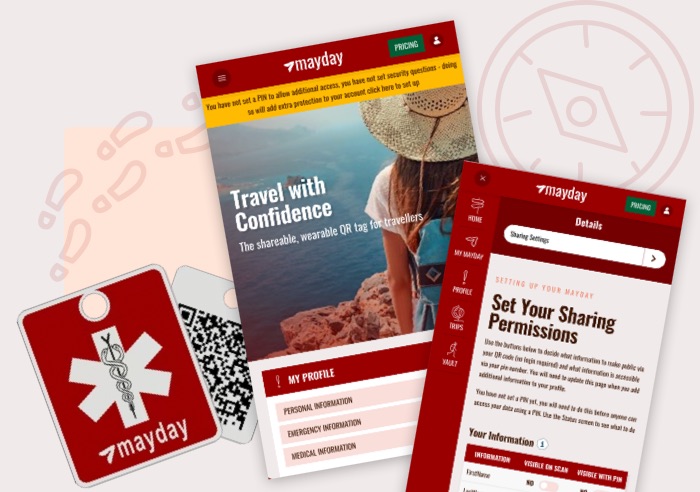
Perhaps you’re finishing university and intending to take a gap year (or two) to travel the world. Maybe you’re taking your family on their first holiday abroad or simply heading off with friends for a well-earned holiday. Whatever the reason, the challenge of storing your travel documents securely, whilst ensuring you have access to everything you need in an emergency is vital. That’s where Mayday comes in.
Mayday is a web portal that can be accessed via a physical QR-coded tag, which can be worn as a bracelet, necklace, or simply as a keychain on a bag. Mayday offers vital support in a range of situations, including:

User experience and security were at the forefront of this project. With highly sensitive and personal information, we needed to be sure that everything was stored securely. Therefore we have added varying permission levels which are controlled by the account holder so that only the correct information is displayed upon scanning the QR code.
Our design team worked closely with our technical team to ensure that we developed an intuitive on-boarding process with clear signposting throughout.
“The Mayday team were a delight to work with. They ‘got’ the brief right away, hit the brand position first time, and delivered on time and on budget.”
James Dunford Wood, CEO
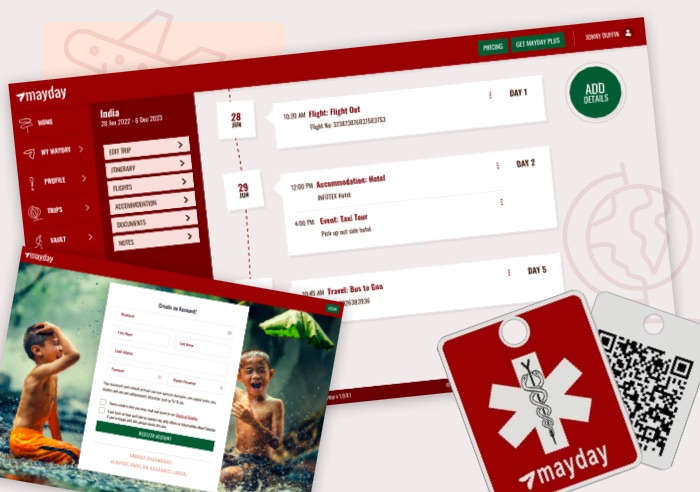
Mayday provides reassurance to both the traveler and their friends and family and we’re excited to continue to support Mayday as the platform grows.
Head over to mayday.travel to take a look and sign up for yourself.
By Mark Hinkes, DPM.
Patient throughput is a pain point for many health care systems worldwide. In the US, when a patient with diabetes wants an appointment for foot care, they merely call the podiatrist’s office and ask for an appointment. Those patients who pay cash, have Medicare or PPO insurance (assuming the provider participates) usually have no problem with coverage. Those patients who have HMO insurance may not have the luxury to go “out of network,” and therefore may not be able to receive your care. Not only are there constraints on access by payor, but the time frame in which a patient may get access to care can vary. Several other questions for practices arise even after addressing payor issues. Is the patient new to the practice or requesting a follow-up appointment? When is the next available appointment? Is the nature of the visit emergent? In any case, access to care is usually achieved in a reasonable time frame.
In the US, we often take the ease of scheduling an appointment with a podiatrist for diabetic foot health care for granted. But scheduling an appointment in health care systems in other countries can be lengthy, complex, frustrating, and can result in unintentional tragedies. Some health care systems are not fine-tuned for patient throughput and patients with diabetes may become subject to a series of what might seem unreasonable bureaucratic steps that delay care. All too often, the delay in accessing care means that a problem that was at one time non-acute becomes critical and may require hospitalization or even result in an amputation.

Here is a story about a typical experience of a patient in a bureaucratic single-payor system that has a pain point with the issue of patient throughput. James is a 65-year-old male with type 2 diabetes and obesity. His blood sugars ran slightly elevated over many years and despite the recommendations of his primary care physician, he pretty much ate what he liked and used tobacco without regard to the long-term effects on his health. His attitude was quite cavalier. “Whatever it is, it won’t happen to me,” was his mantra. He lived a life of denial.
He recently developed a “sore” on the bottom of his right foot and only realized he had developed an ulcer when he saw blood and some exudate on his sock. Thinking the problem would heal itself in due time, he opted not to go to his primary physician, but instead to “give it some time to heal on its own.”
After waiting for a month, he realized the ulcer was not going to heal and in fact, a wound that was the size of a dime a month ago was now the size of a quarter and much deeper than he remembered. The development of redness and tenderness in his foot was the catalyst that made him ask for an appointment with his physician.
James lives in England and his health insurance is paid for in his taxes, so he, along with an avalanche of people, receive their health care from NHS England with no charges, deductible, or co-pay. Often times the demand for care is higher than the system is able to support and this is where patient throughput becomes an issue.
It is important to understand the cycle of events that James went through for an appointment to see a podiatrist. James first needed to get an appointment with his primary physician for an evaluation. That could take up to 14 days. If the primary physician felt unable to treat his ulcer, a consultation referral would be made by an acknowledgement letter (no phone call, no email, but by a letter!) to a podiatrist. Another 14 days could pass before acknowledgement of the consult request. Once identified as needing podiatric care, the actual appointment could be delayed for another 4 to 6 weeks. So, James could wait/in the queue for 8 to 10 weeks before he gets access to care. The longest a patient will wait from the time they are referred to the primary physician and before starting any podiatric treatment could be 18 weeks, or well over 4 months! (1)
James was eventually seen by a podiatrist and later hospitalized for treatment of his infected ulcer, which led to a below-knee amputation of his right leg.
The scenario James experienced has likely played out for thousands of people needing foot health care from NHS England. James was not alone. The most frustrating result of throughput issues is that patients are stranded in the queue and care is delayed. It is quite likely that had these patients been seen more promptly, their foot health issues may not have required treatment of complications requiring hospitalization, and in some cases amputations, both of which generate increased expenses.
The facts are that around 2 to 2.5 percent or around 60,000 to 75,000 patients with diabetes in England have an ulcer in any given week. There are over 7,000 lower limb amputations in people with diabetes in England each year, and the likelihood that someone with diabetes will have a leg, foot, or toe amputation is around 23 times that of a person without diabetes. Every year, approximately 8 out of every 10,000 people with diabetes undergo major lower extremity amputation (above ankle), and 18 out of 10,000 have a minor amputation (below ankle). (2)
While there has been significant progress in identifying at-risk patients and facilitating their entry into the system for medical care, NHS is working with one company who has led the way with a unique digital tool to facilitate patients’ throughput and more prompt access to foot health care. Their efforts have accelerated a change from using 19th century methods to a 21st century solution to one aspect of the problem of patient throughput.
To address the patient throughput issue to podiatry services that would lead to better access to care, NHS is working diligently to resolve the problem with Infotex, a London based digital health company. Infotex designed a digital self-referral tool for patients who would like an appointment with an NHS podiatrist that literally lets them skip the process of an appointment with their primary physician, saving 28 days of waiting time in the queue. The tool prompts patients to answer a series of questions and asks for a photo of their foot. A podiatrist at NHS reviews the documentation and decides on the nature of the foot problem, the immediacy / necessity of care, the type of care needed, and the location of the care.
The Infotex tool thus facilitates patient throughput by removing one time-consuming step in access to care. It expedites care by directing the patient’s request for foot care directly to a podiatrist who evaluates the request and refers the patient to the appropriate provider. It will be interesting to see how this tool impacts patient outcomes in England and what other countries, like the US, can learn from its results.
Dr. Mark Hinkes is a Doctor of Podiatric Medicine who recently retired from clinical care after 40 years’ service. 20 years in private practice in Miami, FL and 20 years at the Veterans Affairs Medical Centers. In Nashville, Tennessee he served as the Chief of Podiatry Services and Director of Podiatric Medical Education. He has been the Chairman of the Preservation Amputation Care and Treatment (PACT) Program for over a decade.
1. Personal communication with Deborah Keating, Head of Sales, Infotex
2. Improving footcare for people with diabetes and saving money: an economic study in England (PDF) Diabetes UK. Available here . Published January 2017. Accessed April 20, 2022.
As anyone using computers knows, the pace of change is higher in this industry than almost any other and the web is often considered to be at the forefront of that constant evolution.
This is exciting for those who, like us, enjoy the technology but can equally be challenging for those who have a less technical interest but need the web to fulfil their business needs, look good and drive their business forward.
PHP Upgrades
WordPress is a Content Management System (CMS) that is written in the programming language PHP. PHP has been around since the 1990s and gets minor updates (generally bug fixes) every few months and these are something that we deal with silently in the background as part of managing your website. PHP also receives larger updates once per year – often adding new functionality, changing how existing functionality works and can even remove existing features.
In 2021 we updated all our WordPress sites to PHP 7.4 which required amendments to a number of sites to make sure they continued to run safely and securely.
During 2022 we need to move these sites from PHP 7.4 to 8.0 as the current 7.4 will reach the end of its service life in November 2022. This means version 7.4 will no longer receive security updates putting any sites still running on it at greater risk of attack and invalidating security mandates required for many schemes, such as Cyber Essentials and ISO-27001.
PHP 8.0 is a major release and makes a range of changes as to how the engine works. In tests, we have seen performance gains of around 5%, as well as cleaning up several interface inconsistencies within PHP. However this comes at a price – some of these improvements are not compatible with existing code, to take a simple example, a commonly used function to check if something exists within a data structure (which has been part of PHP for over 20 years) will no longer be permitted and any code using that will need to be amended to perform the same check-in a different way to avoid errors.
2023 will see us move these sites on to PHP 8.1 and you may ask why don’t we jump from PHP 7.4 to 8.1 today and negate that work next year? The truth is that the WordPress ecosystem isn’t yet ready for PHP 8.1, even the WordPress core has only stated compatibility a matter of weeks ago, which leaves plugin and theme authors some way behind.
The Infotex development team has started testing for PHP 8.0, which has shown that some of our clients, particularly those with non-WordPress powered sites, will have significant compatibility issues with PHP 8.0 due to the changes, and our account managers will be in touch with those clients to discuss options in more detail.
Server Operating System Upgrades
As mentioned last autumn, we had just completed the migration of our CentOS 8 servers to the newer CentOS 8 Stream due to a change of approach from the maintainers of this server operating system at relatively short notice.
While CentOS 8 was originally planned to support us through until 2029, with the forced switch to CentOS 8 Stream, that timeline was cut to May 2024 with some limitations in the interim. This date is also close to the June 2024 end of service life date for our remaining CentOS 7 servers.
Most WordPress sites will be able to upgrade to a new operating system relatively smoothly as part of the move to PHP 8.1 and MySQL 8 over the next 2 years. However, some older sites are likely to have more compatibility issues and for those impacted clients our team will provide you with more information as applicable.
Choosing a platform for your ecommerce website is never easy. Finding the right combination of price, functionality, ease of development, performance and security to meet your unique set of needs can be a real balancing act – especially in a rapidly evolving market, writes Managing Director Ant Agar.
For more than 20 years, Infotex has been on a journey of discovery: we’ve seen technology change, watched a multitude of platforms come and go and, of course, we’ve built our own as well. It’s safe to say that, over the years, we’ve learned a lot.
In the early noughties, we dabbled with a handful of open-source shopping systems but ultimately found them restrictive, both technically and creatively. We much preferred bespoke development, because it enabled us to guarantee our clients that their ecommerce system would work and would do the things they specifically needed of it.
That commitment to our customers, and desire to work collaboratively to build products that directly answer a need, led to the development of our flagship products: “MozCart,” “SpaceCart,” and “FlexiStore,” as well as, over time, more than 100 more. They were a huge success for high profile customers including Micro Scooters, Adnams and Nomad Travel. And many of the products are still live today.
But the age of bespoke, like the age of steam, had to end. Budgets were squeezed and clients increasingly expected generic features and third-party integrations via plugins.
Responding to the changes, we developed ecommerce libraries on Symfony and explored Drupal commerce. We also noticed that clients were starting to request Magento sites but, although we looked into the software and supported some clients with their Magento systems, it just was not the right fit for our clients at the time. The majority of whom are small businesses with under £10million of annual sales online.
But Magento remained a name on many people’s lips. In 2017, I attended the Magento conference determined to figure it out, once and for all. And I’m glad I did. I came away with a much clearer understanding of the platform itself, the ecosystem around it, the investment it requires and the businesses it suits.
So, is Magento a good choice for your business? Here are my key takeaways:
Budget
If the maximum budget for your new website is less than £80,000, you should consider carefully whether you will be able to achieve a good implementation.
Of course, there will always be plenty of providers out there who will say they can do it for less, but this isn’t the place to skimp.
We often hear of clients who are struggling to get the Magento platform working well for them, because they’ve under-invested in the build and underestimated its complexity to manage.
Hosting
This is another core area in which we often see businesses underestimate. Magento’s complexity can be its strength, but it does mean that powerful hosting is a must.
In our experience, businesses need a budget of several hundred pounds per month for the level of hosting required. If that doesn’t sound feasible, it might be wise to consider an alternative platform. There’s absolutely nothing worse than a slow site.
Sales
Do you have thousands of products to sell, hundreds, or just a handful?
The volume of product you’re shifting is going to dictate whether or not the Magento system will be a worthwhile investment.
Ongoing Investment
Magento isn’t a system that you can leave to run itself. Its complexity means that it does demand ongoing investment in both time and budget.
From my understanding, the associated monthly running costs are in the thousands, not the hundreds; and the time and effort involved can be a challenge.
You will need to keep investing if you’re going to continue to deliver reliable performance and the expected user experience.
The table below is intended to help you think about which platform might suit you best.
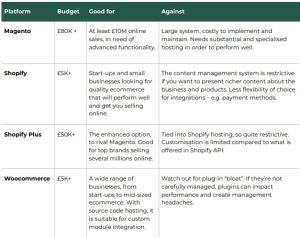
The decision to implement a product like Magento will bring cost and complexity, so it’s important to consider whether your business is the right size and shape. Our experience has been, for nearly all of our clients, that the less complex platforms can deliver all they need to grow their brands and online sales. In short, the time for Magento is when you are no longer worried about the website cost, as your business is large enough to have plenty of other things to worry about!
If you need support or guidance on what ecommerce website is right for you, we can help. Get in touch today, and we can help make a website that works for you.
Infotex’s primary base of WordPress sites are not affected by this but do check your external systems.
First developed in 1995, Java is a popular programming language that you may be using without even knowing it! All Android phones are based on the Android Runtime which is itself a derivative of Java.
Java is a very structured language known by developers for embodying Object-Oriented-Programming methods and being platform agnostic, i.e. code written in Java will run equally well on Windows, Apple’s MacOS, Android phones and a plethora of esoteric platforms.
At one point it was commonplace to embed Java “applets” into web pages, however due to the power of Java this was found to be a very risky practice and modern browsers do not permit this.
In computing most systems output status updates for diagnostic purposes, some systems make these available to users while others hide them from public scrutiny by writing to logs thus allowing developers to understand what went on when something failed.
Log4J is a utility overseen by the well known Apache Foundation which is coded in Java and is designed to process log requests either from Java applications or third parties and can apply a raft of highly complex rules to understand when a status update is routine vs. critical in nature.
Because it is so powerful yet easy to configure, this has been used in a wide variety of purposes, both bundled with Java systems and deployed to process logs from other systems (one example might be to take web server logs and promptly raise a support ticket when certain classes of error occur).
There is a highly publicised bug in Log4j from version 2.0-beta9 – 2.14.1 which is technically known as CVE-2021-44228 but more commonly by the nickname “Log4Shell”.
This was announced on 9th Dec 2021 before its maintainers were even aware of it, it appears attackers had been taking advantage of it for at least a week prior and as such is given the “Zero-day” moniker and scores the highest possible severity rating of 10/10.
Basically, on systems not configured with formatMsgNoLookups, the vulnerability allowed an attacker to create a request which would be processed by Java’s Naming & Directory Interface (JNDI) and would cause the server to make an external request and potentially execute code provided by a third-party attacker. That’s about as bad as things can get when a system is intended to process logs that anyone can initiate in web scenarios.
There are already reports of attackers using this bug to run bitcoin miners earning money for the attacker on afflicted servers.
Fixes were provided by log4j’s maintainers in version 2.15 with a subsequent release to more fully disable potential attack vectors in 2.16.
The US Cybersecurity and Infrastructure Security Agency (CISA) estimates that there are hundreds of millions of devices that are (or were) vulnerable to Log4Shell.
Infotex’s core online platform is WordPress which runs on a PHP platform and none of our log processors run log4j, nor do our client servers have Java installed.
As such our primary base of client sites are not affected.
Since the news of this vulnerability broke on Friday our team reached out to a number of specialist suppliers who offer services (e.g. custom search facilities) to specific clients which could be impacted and have received confirmation from those suppliers that fixes are being, or have already been deployed.
We have also evaluated a number of tools that we use internally (Log4j is also in use on some desktop utilities although the window of opportunity for an attacker there is minute as those systems are not available for attack online) and we have installed updates where applicable for these tools.
We frequently recommend Cloudflare as a security & performance option to clients and it is worth noting that any websites with Cloudflare’s WAF deployed were protected from attack soon after news of this issue broke as they enabled an emergency firewall rule to block potential exploits.
If your website is managed and hosted by Infotex then the likelihood is that you do not need to take any action. If you have websites hosted by anyone else, then you will need to check with those respective hosts to clarify their position. You should also check that you do not have any vulnerable installations of Log4j on your desktop or devices within your business, as it can be utilised in desktop programs.
There are several resources online trying to pull together software vendors statements clarifying whether any updates are needed etc.
One such list can be found at: https://gist.github.com/SwitHak/b66db3a06c2955a9cb71a8718970c592
Keeping your computers and website safe is a constantly evolving challenge and requires co-operation from all parties and this demonstrates the need to know who provides what and ensure that they are managing those systems effectively.
We have collaborated with Suffolk GP Federation to design and deliver a brand new system, designed exclusively for Podiatrists in order to:
This past week, the team travelled to Liverpool to officially bring the new self referral platform to market at the Royal College of Podiatry conference, held at the legendary ACC Liverpool venue. This gave us an excellent opportunity to engage with potential buyers, and users to further strengthen the system.
The College of Podiatry conference is the largest of its kind in Europe and we showcased our exciting new system, designed to improve outcomes and support the patient pathway as well as deliver practical help for clinicians.
While there, we offered live demonstrations of the platform, both the administrative back end including how clinicians could tailor the system to their specific particular practice and also the pathway through which the patient is guided.
“This system enables those with the greatest medical need to access podiatrists with the right skillset to give the best care for that patient. All the while reducing the number of wasted hours, improving patient outcomes and giving the patient agency over their own care pathway. This makes life easier for GPs, Podiatrists and most importantly patients.
The brilliance is in how adaptable this is. The different elements can be customised to then suit the needs of the service. During the pandemic Suffolk GP Fed had to drastically change how we handled our podiatry caseload. Despite everything we were still in a position to give advice and support to new patients, and focus our resources on saving the limbs of those most in need all thanks to our referral system.”
Philip Holloway – Podiatrist / Suffolk GP Federation
We also ran a prize draw in which entrants had to guess the right answer to a footie question! Overall, it was an excellent show and the podiatry community are a fantastic bunch to be around.

Though created specifically for Suffolk GP Federation and podiatrists, the bones of the system offer a very solid and exceptionally efficient pathway for any customer or patient type via full end to end onboarding, assessment, appointment scheduling and appropriate advice.
It is a clinician lead system design, and can be adjusted exactly as required. All outcomes are based on carefully planned question sets which you can alter to support your clients and practice behaviours.
Please contact the team to book a demo.
The year is 1991, Operation Desert Storm is in full swing in Iraq, the Soviet Union is being dissolved, the Channel Tunnel has yet to open, and Tim Berners-Lee announces the World Wide Web project.
Against this background a computer science student studying at the University of Helsinki, Finland, called Linus Benedict Torvalds posts to a NNTP usergroup (a precursor to web forums) on 25th August 1991:
“Hello everybody out there using minix –
I’m doing a (free) operating system (just a hobby, won’t be big and professional like gnu) for 386(486) AT clones. This has been brewing since april, and is starting to get ready. I’d like any feedback on things people like/dislike in minix, as my OS resembles it somewhat (same physical layout of the file-system (due to practical reasons) among other things).
I’ve currently ported bash(1.08) and gcc(1.40), and things seem to work. This implies that I’ll get something practical within a few months, and I’d like to know what features most people would want. Any suggestions are welcome, but I won’t promise I’ll implement them 🙂
Linus (torvalds@kruuna.helsinki.fi)
PS. Yes – it’s free of any minix code, and it has a multi-threaded fs. It is NOT portable (uses 386 task switching etc), and it probably never will support anything other than AT-harddisks, as that’s all I have :-(.”
His new Operating System was initially only permitted for use on hobby machines with restrictions against use in commercial environments.

Oh, how the world has changed beyond Linus’s wildest dreams!
Fortunately in the last 30 years, Iraq has returned to a relative peace, the Channel Tunnel has come to take around 1/3rd of the passengers travelling from Dover to France, the World Wide Web project can be considered a success with around 2 billion sites now online, and Linus has relented to allow commercial activity based on his operating system!
His “hobby” operating system has now become “big and professional” itself, powering the majority of websites in use in 2021.
In 1996 Linus Torvalds proposed a contest to design a logo for this new operating system, which he suggested resemble a penguin “stuffed to its brim with herring”. Thus a black, white and yellow penguin designed by Larry Ewing came to symbolize the operating system and was subsequently named Tux (purportedly standing for Torvalds Uni-X).

Linux is open-source software meaning that anyone can download the entire source code from www.kernel.org and anyone who has created an account can propose amendments to the operating system, which is one reason it has been so successful.
The size of the code has increased significantly over time, from the mere 7,400 lines of ‘C’ code in version 0.11 to around 17 million lines of code in the current version, yet the structure of the two codebases is very similar. All the additional code is there to incorporate features such as native containerisation, virtualisation support, and the ability to run on an amazingly wide range of hardware.
Linus himself still plays a major role in the direction that Linux takes. Given the size of the project and the number of contributors, there are several managers who oversee specific areas of development, but anything outside of that requires Linus’s approval, even today.
Where Linux differs from its competitors such as Microsoft Windows is that it requires such low levels of system resource (CPU / memory etc.) so it can run in a wide variety of systems – including TV’s, car dashboards, even household fridges! It is also more stable than most other alternatives, with servers rarely needing a restart except for the installation of security updates – try running Windows 10 for a year without rebooting!
Infotex has been running various versions of Linux on the majority of our web servers for more than 20 years, and some of our staff use it on their desktop computer as well.
We’ll be raising a glass to Linux on the 25th August to celebrate Tux reaching its 30th birthday, and we look forward to celebrating many more years to come. Few would have guessed where Linus’s little hobby from 30 years ago would be today and it’s hard to imagine what the world, especially computing, will be like in another 30 years time!
Internet Explorer was first released in August 1995 as a core part of Windows 95. It raised controversy at the time for the fact that it was bundled into Windows, resulting in lawsuits against Microsoft for monopolistic practices. This lead, in no small part, to the downfall of the previously leading browser Netscape Navigator.
Internet Explorer, or IE in tech circles, became the defacto standard and by the early 2000s over 90% of all browsing was being performed via Internet Explorer.

Competitors started to challenge for Internet Explorer’s throne, with potent competitors in the shape of Mozilla Firefox emerging in 2004, and Google releasing the first Chrome in 2008.
Firefox and Chrome took a new approach to browsers, with regular updates adding new features, which developers could leverage to create a more interactive web. IE started to lag with updates being few and far between, generally being bundled into their large Service Packs.
Starting with Windows 10 (and retro-fitted to Windows 7) Microsoft eventually moved their main browser to Microsoft Edge which has subsequently been re-architected to share the rendering engine underpinning Google’s Chrome.
So where did this leave Internet Explorer? Internet Explorer 11, released in 2013, is the last version of the platform and is still installed on the majority of Windows 10 PCs for compatibility purposes, but buried away to encourage people to use Edge. Unlike IE, Edge receives regular updates keeping pace with its main competitors. Currently Edge sees around a 5% market share, far below the lofty heights that previous IE versions once commanded.
Today, Internet Explorer languishes at around 1% market share which is almost entirely within large corporate networks, often running internal systems with lengthy update cycles and / or legacy software.
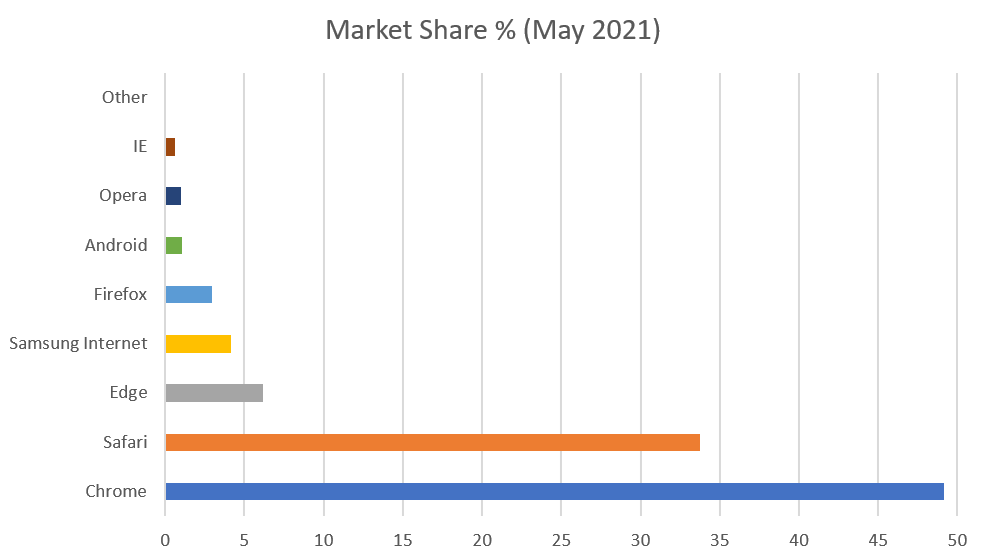
In 2020 Microsoft acknowledged that Internet Explorer has reached the end of the road and that they plan to cease support for it within their Microsoft Office 365 suite with effect from August 2021.
With the release of WordPress 5.8, which is scheduled to occur in July 2021 we will see WordPress, the dominant website Content Management System (CMS), cease support for Internet Explorer 11. As primarily WordPress agency Infotex will be following suit.
By ceasing to support a browser, this means that we will no longer be targeting it during development or testing that your website functions correctly on Internet Explorer. This allows us to focus on browsers that support modern CSS & JavaScript features, offering greater interactivity and performance than was previously possible.
At this time we will not be taking actions to specifically cause your website to be unusable by Internet Explorer so you are unlikely to see any immediate impact. However, unless specifically agreed to the contrary, we will also not be fixing any Internet Explorer specific issues which occur going forward. This means that over time your website may become less usable within Internet Explorer.
WordPress have similarly stated that they will be removing testing for Internet Explorer 11 gradually over versions 5.8 & 5.9 and it is anticipated that the first area that will be impacted will be the content administration areas which utilise modern features to provide the high levels of user experience that site administrators come to expect today. Users on Internet Explorer 11 and earlier may also see a banner within their administration areas advising them to upgrade to a more modern browser.
Goodbye to the friend we all loved to hate and welcome to a more interactive web of the future!
Progressive web apps are essentially web applications that feel and function like a native mobile application. They continue to gain traction due to the positive impact they have on user-experience: advanced capabilities such as offline use and push notifications, and the ability to be “installed” on the user’s device.
PWA’s encompass the best things about a native phone app along with the flexibility and instant nature of the web.

An app, or application, is simply a piece of software designed to serve a purpose. This can range from simple applications such as a calculator through to more complex applications such as word processors.
A native application is one that is designed for a specific device. An application designed for a specific device will often have deep access to that device’s functionality and will be able to maximise performance and integration through the device’s API’s.
Modern applications, such as those within the iOS app store, have to follow strict rules in order for them to be available to download on a user’s device. These rules are intended to improve security, performance, and experience. Apps within these stores are there at the whims of the platform owner and rules are not always obvious nor technically motivated (such as whether to allow a competing payment provider).
Web applications are written for browsers. They utilise various platforms and libraries to provide an experience that can be accessed anywhere. A single website application is able to target desktop, mobile, tablets, tv’s, consoles etc all from a single codebase.
Web applications leverage the inherent power of the internet offering high levels of discoverability and a vast ecosystem of 3rd-party providers, tools, and integrations.
For all of the freedom they provide, web applications require launching a browser and typing an address to access them and they typically do not have access to the same device features as a native application (such as the local file system storing your media, camera, microphone, fingerprint scanner etc).
Progressive web applications are intended to close this gap by offering the advantages of a web application whilst behaving more like a native application on a user’s device (such as the ability to be “installed” and access to more device features).
Progressive web applications leverage a variety of technologies to provide an experience as close to native as possible – so it may be best to think of them as a design/development philosophy. There is no single test to prove that a web application is a PWA although there are tools, such as Google’s lighthouse, that will attempt to score the application based on the presence of certain features.
That said, there are a number of features that exist within PWA’s:
A service worker is a script that intercepts requests and allows for the control of functionality such as caching to allow the web application to function whilst offline and background services.
They offer a lot of potential by responding to, and controlling, data even when the user is not actively using the web application – such as push notifications.
This is a file that describes how the web application appears in the context of the device it is on. For example it dictates the icon displayed when the web application is installed on the device.
The web application must be served over HTTPS in order to have access to features such as service workers.
Many modern websites that you visit are actually using progressive web app technologies to provide an experience closer to that of native applications. You can see this when you visit sites like Twitter, Gmail, etc.
If you want to install them, you can simply utilise your mobile browsers built-in functionality. This varies from browser to browser; On Chrome for Android, for example, PWA’s get an “Install app” link in the browser menu. Whilst any site can be added to your home screen, PWA’s can be installed and will provide you with a more immersive experience when you do this (crucially they will launch in their own window with no browser interface, have a nice icon, colours matching the app, etc).
The functionality available to web applications through browser API’s is improving all the time which means that PWA’s will become more sophisticated and able to offer you parity with your native applications. This means you get all of the benefits of the web whilst still being able to offer a great experience on individual devices.
If Netflix has you hooked, then it won’t take you long to get your head around the concept of smart content loading. Have you noticed that today the ads on your computer screen are selling you exactly what you were searching for yesterday? We’re moving into a world where user data is personalising our online experience, and customers are happy to hand over their details for the right results. It’s no wonder 47% of consumers check Amazon if they’re unsatisfied with the products suggested by the brand they’re shopping with – the personalised shopping experience is too good to resist. Well, now there are increasing opportunities for smaller businesses to tap in on this consumer impulse.
Smart Content refers to the dynamic elements of your website that change depending on the site user profile. Instead of being restricted to typical static content, which stays the same for everyone, smart content offers some important benefits: it targets individual customers with a personalised experience, and also increases site loading times. These things combined mean that a website with smart content loading built in will drive significantly higher conversion rates and ROI than one without.
In order to determine which tailored content to show when a unique user visits the site, smart content responds to demographic/firmographic user data (age, gender/business details) as well as behavioural (on-site activities and history) and contextual data (location, device type, time of day). This way, websites can optimise their content to increase engagement through offering visitors only the most relevant material. For example, your smart content system could tweak a landing page instantly when it knows a certain user has visited the page before, offering them a new and more relevant response the second time around. By finding out who your customers are, you can offer a friendly, personal service that keeps them coming back again and again.
Site loading speed is always a priority for engaging users. But businesses are also increasingly opting for smart content loading with the same aims of maximising page visits, time on site, and reducing bounce rates. As a development of “lazy loading”, whereby site images are only loaded when necessary, smart content loading websites limit downloads to the necessary content for a particular user, saving time by withholding unnecessary text and images.
If your potential leads have varying needs, interests, desires, or character profiles, then you should employ using smart content loading.
Some examples of the types of smart content you might create include targeted blog posts and articles, personalised calls-to-action and case studies, discounts and offers, and video content. You don’t need to go full steam ahead to begin with, but gradually segmenting the traffic to your site will enable you to make the most of your business online and keep those potential leads returning.
However, the aim is to offer a personalised, suitable experience without appearing overly familiar… no customer wants to feel like they’re being watched without remembering giving permission, so there are some things to avoid, too. For instance, unless it is a situation where the user will definitely remember their prior visit to the site, smart content loading should avoid using a user’s personal details such as their name and location.
Technology is creating amazing opportunities for small businesses online, including smart content loading. If you feel like your business is too small, or too far behind the current internet trends, you’re wrong! There’s never been a better time to join in with the excitement of web development and help your business outcompete the rest.
Get in touch for website advice, or read about more top website trends for 2021 in our blog.
If you have an e-commerce website, or utilize content marketing, Web Push Notifications could be the next step for you to keep re-engaging with your website visitors, allowing you to reach them on any device, without them needing to hand over any personal data.
We’re all familiar with regular push notifications: the banner notifications that come from the apps on your phone, such as a missed call, unread text notification, BBC news update, new match on Tinder. If you have enabled notifications for any app, that app is able to use the phones operating system to send you messages. Everyone with a smartphone knows how engaging these notifications are, grabbing your attention in real-time, with direct access to your screen no matter what you’re doing.
It is commonly believed that this type of customer-engagement marketing is limited to those who have a ‘native app’ (that is, an app that customers have to download onto their phone from the app store in order to access it’s features). However, with the efforts being made by Google and Apple to explore and move towards ‘progessive web apps’ (apps that you don’t need to download from a store, more like a website), more and more of the features of smartphone operating systems are available to improve and enhance your website or online marketing… without needing to develop a native app.
In the same way that when you install a native app on your smartphone your app asks the user for permission to access notifications features, your website can ask new visitors for approval to send them website push notifications. Once this ‘visitor’ has become a ‘subscriber’, you can then send them notifications from the website in the form of customised text, URL links, and images.
Web push notifications instantly offer some big improvements from other forms of notification marketing and native app notifications (e.g. newsletters, SMS).
You might now be wondering how to use push notifications in your marketing strategy. While the technology is not that new any more given it’s been used on every smartphone over the past 10 years, it’s introduction into a new medium (website) does mean that we can be a lot much more creative.
These are just a few of the more obvious ways to implement push notifications. But with the wealth of creative minds in our industry it is likely to be used in new and exciting ways. We have already created a push notification for a green lobbyist client, that allows them to send push notifications on their articles, but also send out real time smog warnings for affected cities or other urgent messages.
If you would like to talk more about push notifications and now it could improve your website marketing, please do not hesitate to get in touch.
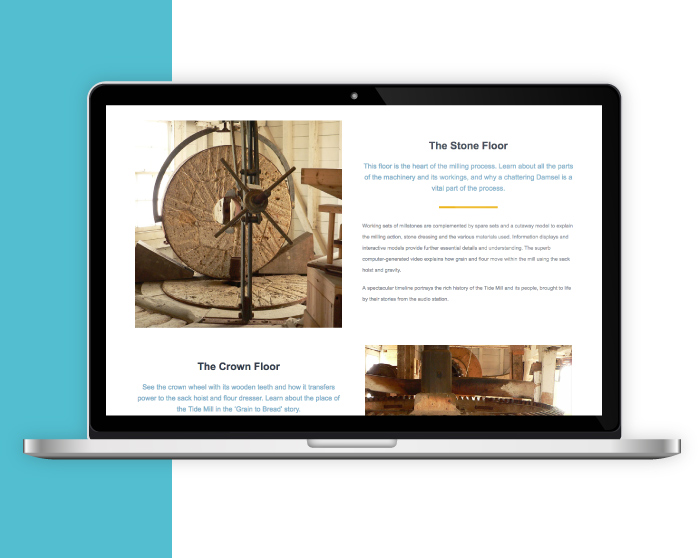
Situated on the banks of the Deben, the Woodbridge Tide Mill has been harnessing the power of the river for over 800 years. Continuing to mill to this day, it is ranked as the number 1 thing to do in Woodbridge (TripAdvisor) and required an updateable website to entice and educate potential visitors.
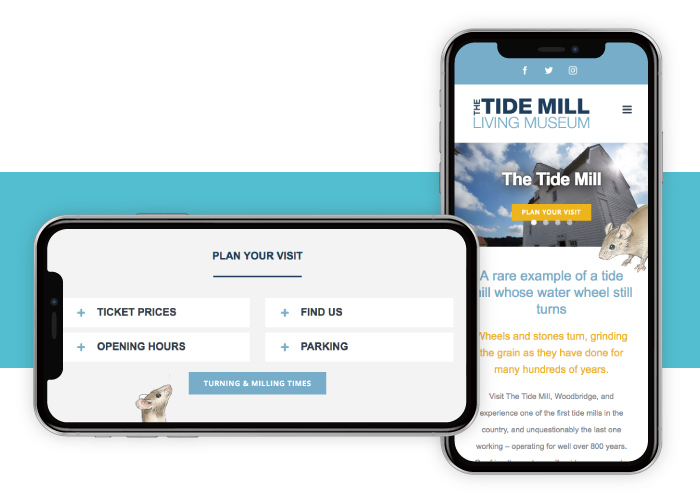
Using the existing branding we incorporated a bright and bold website, that’s easy to navigate to make sure information is quickly found. Key information is available on every page, and details such as the Tide Mill Mouse and a flowing “swoosh” sets the design of the site apart.
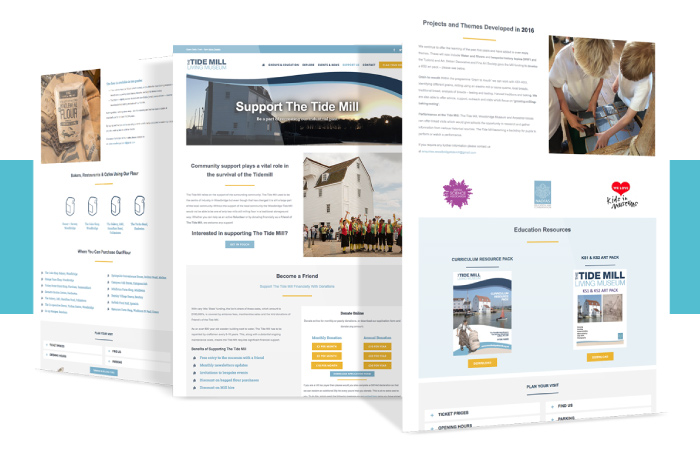
The Tide Mill is a charity and receives little state funding, so the majority of upkeep costs are provided by the community and friends. We advised on using GoCardless which allows for cost effective regular repeat donations automatically, alleviating administration and complex paperwork. The site also invites people to be a volunteer, with milling roles through to PR and fund raising positions available.
Infotex have been delighted to support the Tide Mill, and look forward to many more years of milling and turning.
Why not take a look woodbridgetidemill.org.uk
Discover how our team can help you on your journey.
Talk to us today